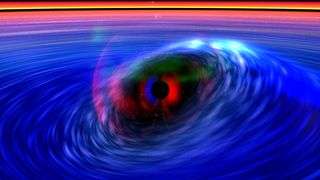Proposed NASA Mission Could Explore Twisted Space Around Black Holes

A new NASA mission could discover the shape of space that has been distorted by a spinning black hole's crushing gravity, and explore the structure and effects of the formidable magnetic field around magnetars, dead stars with magnetic fields trillions of times stronger than Earth's.
Current missions either don't have the resolution to do this, or in the case of magnetic field imaging, simply can't do this because magnetic fields are invisible. The proposed new mission, called Gravity and Extreme Magnetism (GEMS), will use a new technique to accomplish what has been impossible until now. It will build up a picture indirectly by measuring the polarization of X-rays emitted from these violent regions.
X-rays are just a powerful kind of light. Like all light, X-rays have a vibrating electric field. When light travels freely through space, it can vibrate in any direction. However, under certain conditions, it becomes polarized, meaning it is forced to vibrate in only one direction. This happens when light scatters off of a surface, for example.
We take advantage of this phenomenon when we use polarized glasses to reduce road glare. The glare is simply light that has become polarized by scattering off the road. The glasses are made to block polarized light, so they eliminate the glare.
"The extreme environments around black holes, magnetars, and the shocks from exploding stars called supernovae all produce X-rays," said GEMS Principal Investigator Dr. Jean Swank of NASA's Goddard Space Flight Center in Greenbelt, Md. "GEMS will be the first mission designed just to measure the polarization of these X-rays, which will enable us to explore these exotic places in an unprecedented way."
GEMS could reveal:
* How spinning black holes affect space-time and matter as it is drawn in and compressed by strong gravitational fields.
* What happens in the super strong magnetic fields near pulsars and magnetars.
* How cosmic rays are accelerated by shocks in supernova remnants.
"GEMS will be able to tell the shapes of the X-ray-emitting matter trapped near black holes better than existing missions can -- in particular, whether matter around a black hole is confined to a flat disk or puffed into a sphere or squirting out in a jet," said Swank.
"Since X-rays are polarized by the space swirling around a spinning black hole, GEMS also provides a method of determining black hole spin independent of other techniques, which is needed to check their accuracy," said Swank.
The heart of GEMS will be a small chamber filled with gas. As X-rays travel through the gas, they release a cloud of electrons along their path. Since the electrons tend to move in the same direction as the electric field produced by the X-ray, the instrument will measure the electron cloud to get the direction of the X-ray's electric field, which is the same as its polarization.
Goddard's GEMS proposal is part of NASA's Explorer program. The proposal was submitted in response to NASA's Announcement of Opportunity for Small Explorers (SMEX) and Missions of Opportunity issued on September 28, 2007. Six proposals, including GEMS, were selected for detailed concept study, following which NASA will select two of them for development in the spring of 2009. One selected mission is scheduled to launch in 2012, and the other is planned for launch in 2015.
If approved, NASA Goddard will be responsible for the GEMS instrument and the overall program management. Orbital Sciences Corporation, Dulles, Va., will be responsible for building the spacecraft and mission operations. ATK Space, Goleta, Calif., will build a boom to place the X-ray telescopes the proper distance from the detectors. NASA's Ames Research Center, Moffett Field, Calif., will assist the project by managing the spacecraft development contract and by providing simulations of how the data will appear. The University of Iowa will provide instrument calibration assistance, and will have students prepare an experiment that could be part of the mission. The Massachusetts Institute of Technology, Cambridge, Mass., will provide help with determining the mission requirements.
Source: by Bill Steigerwald, NASA's Goddard Space Flight Center




















